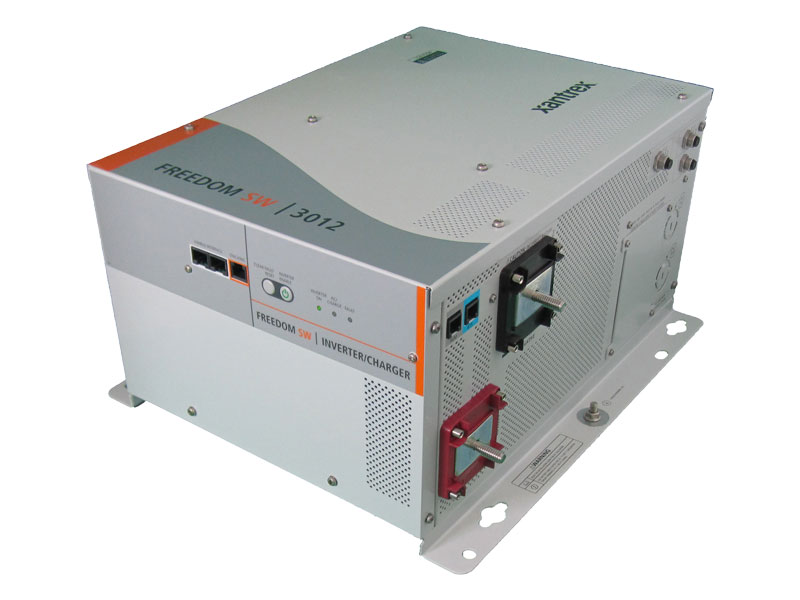The Don Rowe Blog
Nov 12
To Inverter/Charger or Not to Inverter/Charger – Do I Really Need a Combo Unit?

So, you’ve determined you need an inverter for your new build, or perhaps you are looking to upgrade the current system you have, but do you need an all-in-one inverter/charger system? Let’s start with explaining what an inverter/charger is. It is essentially an inverter, transfer relay, and converter/charger built into one unit. An inverter/charger is wired up to your batteries and has wiring for AC input teamed with an internal transfer relay. This relay recognizes when AC power is available then it automatically bypasses the inverter and supplies your loads directly with the incoming AC power. During this time the converter/charger will start supplying a charge to your batteries. The charger will then shut down and the transfer relay will switch back to inverter power when unplugged. Let’s discuss the benefits for three different types of applications, RV/Boat, house, and work vehicle.
RV and Boat
In terms of an inverter application, a boat and an RV are the same. They both have the potential for shore power, an onboard generator and preexisting components, such as built-in converter. If you are in a scenario where there will not be another AC source, i.e. generator or shore power, then there is no advantage to an inverter/charger. It’s fairly safe to say that if you’re doing a new build from ground zero, an inverter/charger is the way to go. Without an all-in-one system you are left to manually track what AC power you have available. However, you do not want AC power available on the same circuit as a standalone inverter as this will result in a damaged inverter. You also have to be sure that the separate converter is never powered by the inverter as this will result in quicker battery drain. If you’re upgrading or adding an inverter to your preexisting system that already has a converter, consider the implication that the converter cannot be powered by the AC circuit the inverter supplies. Beyond the automatic features and the efficiency of an inverter/charger, there are a number of monitoring and adjustment features you can dial in to improve performance. Inverter/chargers either come with, or have an optional remote panel that allows you to monitor you usage and battery voltage. This panel can also allow you to set parameters such as battery type, battery bank size, and AC input restrictions. These parameters ensure you are getting optimized performance and charging, which leads to longer battery life.
House
Most homes do not come with an inverter already installed, so we are likely looking at a new build. A home installation can be broken down into two categories, off-grid and emergency backup. In an off-grid scenario there could be an onsite generator, but if renewable energy is your only source of power generation an inverter/charger would provide very little benefit. With a generator the inverter/charger provides greater efficiency while charging because you are not only charging while the generator is producing power, but you are also supplying your loads, thus resulting in a faster recharge time. Generators require maintenance and fuel, so utilize as much generator power as you can when running it. Emergency backup is an excellent match for an inverter/charger system. Isolate your crucial devices for back up and wire the inverter/charger for those devices. As long as grid power is stable, the grid power will be passed through to your devices while the built in battery charger will keep your battery source topped and ready for an outage. When grid power goes down, your crucial devices will automatically be power by the inverter until either grid power returns or battery power is drained down. In situations where outages span multiple days to multiple weeks, a generator may be required for occasional charging.
Work Vehicle
In many cases a generator for your work vehicle can be replaced by a silent, clean working inverter, but why go with an inverter/charger? With a standalone inverter and auxiliary battery bank you must carry another device to eventually charge your batteries back up. What happens when you get to a job site where power is provided? Do you continue to use you battery power or unplug you necessary equipment to switch over to site power? With an inverter/charger you can rig up the work vehicle with all of your devices where and how you like them, and prep the input for an easy plug in at job sites. This way you can simply plug your work vehicle in when site power is available, or run off battery power when it is not. Just plug in at the end of your work day and the batteries will charge overnight preparing you for the following work day. As an added tip, get a charge isolator and use the alternator power while driving to the next job to charge that auxiliary batteries back up.
Consider your application; does the automatic switching and charging improve power needs? Inverter/chargers are a great fit for many applications and offer benefits beyond what a standalone inverter can. Does it fit yours? If you need any advice or have any questions, please contact us at 800-367-3019 or post a comment below.